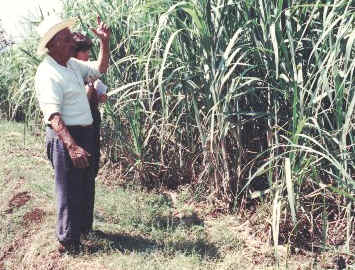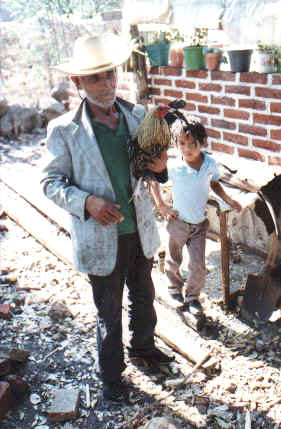 The old house of a sugar producing hacienda, community of Los Limones
The old house of a sugar producing hacienda, community of Los Limones The old house of a sugar producing hacienda, community of Los Limones
The old house of a sugar producing hacienda, community of Los Limones
Agrarian reform in Los Reyes followed a very different path to that of the Ciénega. The region had been relatively sparsely populated, and the original sugar industry was in the hands of companies which made no attempt to resist land reform. The companies had encouraged rancheros from the upland region to move into the region and cultivate cane as sharecroppers, and irrigation water was, and still is, abundant. Despite the fact that much of the present population migrated in after it, the original land reform was, however, chaotic, and some individuals managed to secure more hectares of land than they were legally entitled to. Irregularities in tenure and disparities in individual holdings continue to characterize the ejidos of the region today, although population growth since the 1940s and demands for land for avocado orchards and pasturing cattle have created innumerable conflicts over land.
 Old sugar mill (trapiche) at Los Limones
Old sugar mill (trapiche) at Los Limones
Some of these involve landless villagers attempting to secure land for subsistence farming that was once part of an ejido's grant of pasture land, but had been sold off to local rachers by ejidal authorities in the past. These conflicts have sometimes been violent and have led the land claimants to align with militant agrarian organizations, notably the Unión de Comuneros "Emiliano Zapata" (UCEZ).
The majority of ejidatarios who sow cane have been politically conservative and loyal to the ruling PRI party. But the region has a complex agrarian structure, since there is a considerable amount of private as well as ejido land, and private farmers also grow cane. In the 1960s, the region boomed with the development of avocado orchards. Although the avocado industry is dominated by private capital, and many of the best orchards belong to members of the political and social elite of Michoacán, a substantial number of ejidatarios and small proprietors also have small orchards and are not, therefore, necessarily totally dependent on cane cultivation. Private ranchers make up another important group, along with the owners of trucks and other businesses linked to the sugar cane industry. In addition to conflicts n class lines, ethnic divisions are also important, since the sugar cane zone borders the Meseta Tarasca and there are Purépecha communities within the municipios of Los Reyes, Tocumbo, Tinguindin and Santiago Tangamandapio which play an important role in local politics. Although the county seats of all these municipios are mestizo-dominated, the indigenous communities have provided strong support for the PRD.
Video clip - Click on Quicktime logo to play
Two landless jornaleros from the Barrio Alto of Santa Clara sing a typical ranchero ballad of jealousy, lust, murder and punishment as they relax with family and friends during the cane-cutting season.

An avocado orchard

Ejidatario with one of his cane fields, Santa Clara.

Enrique, a jornalero, who still works in the cane cut. He belongs to the UCEZ and fought successfully to sow a plot of land wrested from the control of cattle ranchers. He had worked in construction in Mexico City and participated in urban social movements in earlier years.